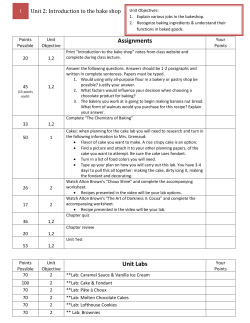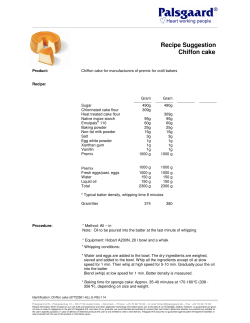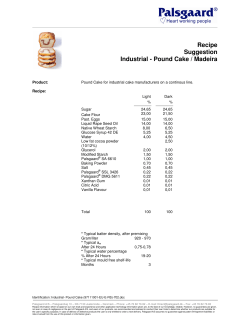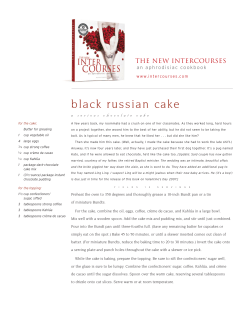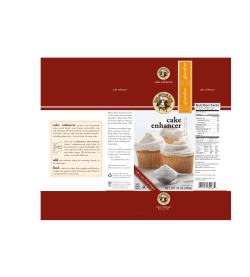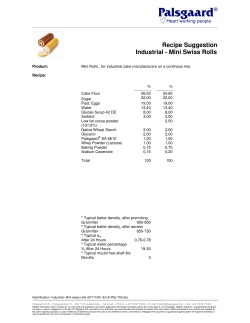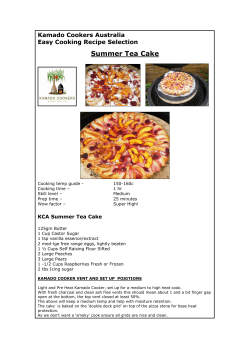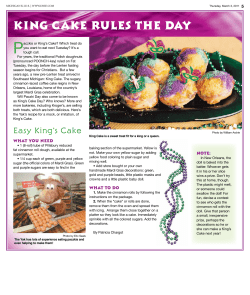
Yellow cake with Aquacel™ GSH cellulose gum
FOOD TECHNOLOGY REPORT Ashland Specialty Ingredients ashland.com Page 1 of 5 FTR-017-1 (Supersedes FTR-017) Yellow Cake With Aquacel™ GSH cellulose gum Consumers and bakery retailers expect high quality and performance from cakes in today’s markets. Uniform crumb, soft texture, high volume and a smooth decorating surface are attributes of such high-quality cakes. Cellulose gum (sodium carboxymethylcellulose, or CMC) has a long history of use in high-quality cakes. Aquasorb™ A-500 CMC has excellent water binding and water holding properties and is used to increase moistness 1 and softness in baked goods to improve shelf life. Aquacel GSH CMC is a high-viscosity, high-performance 2 cellulose gum especially useful in considering hydrocolloid supplementation or replacement needs. In this study, CMC and xanthan gum performances were compared in a high-ratio yellow cake dry mix. Because hydrocolloids each have unique properties and particular benefits in food applications, an understanding of the functions and benefits of each hydrocolloid will help formulators make decisions about ingredients. Executive Summary Cakes were evaluated in aspects important for processors as well as end users; these were batter viscosity and density, baking properties and cake volume, texture analysis and sensory evaluation. Cake batters with hydrocolloids had similar viscosity and batter density, indicating that handling would be similar when comparing one hydrocolloid to another. There were differences in cake performance indicating each hydrocolloid brings unique properties, providing formulators options for using individual hydrocolloids or blends to take advantage of the benefits. The cake with Aquacel GSH CMC had good firmness and height and was preferred by the untrained panel that evaluated sensory qualities of the various cakes. The sensory qualities were identified as attractive crumb appearance and a moist and tender bite. This unique high-viscosity CMC also provides a smooth crust and even crown, making an ideal surface for frosting cakes. The cake with Aquasorb A-500 CMC was similar to the cake with Aquacel GSH CMC in height, but was identified as less moist by the untrained panelists. Aquasorb A-500 CMC is highly absorbent, requiring more water in the initial 1 formulation for improved moistness. The cake with xanthan gum had the most height and firmness but was domed in appearance, which may present decorating challenges. This cake also had a chewy texture, as determined by the untrained panel, which correlated to the springiness identified in the texture analysis. Methods The dry cake mix was made in a master batch (see Table 1) that was mixed on a Kitchen Aid* mixer with a paddle attachment until well blended. All statements, information, and data presented herein are believed to be accurate and reliable, but are not to be taken as a guarantee, an express warranty, or an implied warranty of merchantability or fitness for a particular purpose, or representation, express or implied, for which Ashland assumes legal responsibility. ®Registered trademark, Ashland or its subsidiaries, registered in various countries. ™Trademark, Ashland or its subsidiaries, registered in various countries. *Trademark owned by a third party. © 2013, 2014, Ashland. Rev. 9-2014 Page 2 of 5 Table 1. Dry cake mix formulation Ingredient Weight % Sugar Flour 42.5 41 Vegetable shortening 11 Nonfat milk powder 1.5 Dextrose 1 Salt 1 Sodium aluminum phosphate 1 Sodium bicarbonate 1 The dry mix was weighed into the mixer bowl. For the test cakes, hydrocolloid was blended well into the dry mix. A reference cake with no added hydrocolloid and an additional 0.3 weight percent of cake mix was also prepared. The basic batter formulation is described in Table 2. After mixing, 800 grams of batter were added to a 9 × 9 inch (23 × 23 cm) baking pan and baked at 350 °F (177 °C) for 37 minutes. Several cakes were made from each formulation to enable testing for each variable. Table 2. Cake batter formulation Ingredient Weight % Cake mix W ater 60.6 27 Eggs 11.2 Vanilla 0.9 Hydrocolloid 0.3 Results Hydrocolloids in cakes control batter viscosity and improve texture and appearance. For improved yield and shelf life more water may be added to a cake batter when using hydrocolloids. The reference formulation, containing no added hydrocolloid but the same water addition as the test cakes, performed very poorly with low volume, hard texture and an under baked appearance. CMC- and xanthan gum-containing cakes did not perform identically and had unique strengths and weaknesses. Sensory Evaluation Cakes were evaluated by untrained panelists for appearance, moistness, texture and preference. Samples were blind coded and presented to 12 participants. Panelists found cakes to be similar in appearance. The cake containing Aquacel™ GSH CMC was preferred by panelists. • The cake made with Aquacel GSH CMC was rated as softer than the cake made with xanthan gum. • The cake with Aquasorb™ A-500 CMC was considered the least moist; supporting the practice of adding 1 more water to cake batters using Aquasorb A-500 CMC. • The cake made with xanthan gum was described as firm and chewy; correlating to the springiness results in the texture analysis. • The reference cake was not included in this evaluation as it performed poorly during baking. Cake Baking Properties and Height Cake baking properties were determined by cake appearance in shape and crumb. Cakes with poor baking properties often collapse due to insufficient structure and have a wet and uncooked appearance when cut, indicating too much Page 3 of 5 uncontrolled moisture in the batter. Another common defect is cake shape. Although good volume is desired, a cake with too much height appears pointed or domed. This presents an uneven surface for frosting and decorating and such a cake may need to be leveled before frosting. After baking and cooling, cake height was measured with a caliper inserted into the un-cut cake. Measurements were taken at the approximate center of the cake and at four points about half way between the center and the outer edge of the cake. Differences between the center point and surrounding points can indicate a more domed cake formation. Cakes with Aquacel™ GSH CMC or Aquasorb™ A-500 CMC were similar in height but more rounded and less domed. The cake made with xanthan gum had greater height and a larger difference between the center point and the surrounding points, indicating a more domed appearance. The reference cake collapsed. See photographs in Figure 1. Figure 1. Appearance of baked cakes Cake bake-out properties were also examined visually. The cake with Aquacel GSH CMC had an attractive even crumb and crown. The cake with Aquasorb A-500 CMC had the most even and tight crumb. The cake with xanthan gum was more domed in the center of the cake and an uneven crumb texture. The reference cake did not bake properly. Cake Texture Analysis Cake texture can be a good screening tool. Texture analysis can indicate cake firmness and recovery from compression, among other attributes. Most consumers enjoy soft, tender cakes but with some resiliency, or recovery, so they are not crumbly. Too much resiliency or springiness, however, may be related to a chewy texture. A TAXT texture analyzer (Stable MicroSystems) was used on approximately 3 inch (7.6 cm) square pieces cut from the cakes one day after baking, not including either the side crust or center dome of the cake. The Cake Compression Test from the instrument test library was used, with a 30 mm stainless steel cylindrical probe. Cakes were compressed to 25% of original height, held for 2 seconds, then given a 10-second recovery. Data from the test gave information on cake firmness and springiness. Firmness is the force required to compress the sample, while springiness is determined by recovery from compression; both are reported as force in g. Cakes with Aquacel GSH cellulose gum or xanthan gum were similar in firmness, while the cake with Aquasorb A-500 CMC was softer. The reference cake was very firm and did not bake properly. Cake firmness data are shown in Figure 2. Page 4 of 5 Figure 2. Texture analysis on cakes using TAXT Texture Analyzer Cakes with Aquacel™ GSH cellulose gum or Aquasorb™ A-500 cellulose gum were similar in springiness. The reference cake with no hydrocolloid was low in springiness, indicating it did not recover from compression. The cake containing xanthan gum was highest in springiness but this resulted in a chewier texture. This correlates well with the findings of untrained panel that found it to be objectionably chewy. Cake springiness data are shown in Figure 3. 80 Texture analysis: Springiness 70 60 Force, g 50 40 30 20 10 0 Aquacel™ GSH Aquasorb™ cellulose gum A-500 cellulose gum Xanthan gum Reference Figure 3. Texture analysis on cakes using TAXT Texture Analyzer Batter Viscosity and Density Batter viscosity impacts mixing conditions and filling operations for automated processes. Batter density is an indication of air entrainment during mixing and also influences filling operations and cake volume. In this study all hydrocolloids similarly increased batter viscosity and decreased density, indicating that cake processing will not be greatly affected by hydrocolloid choice. Immediately following mixing, viscosity was measured for each cake batter using a Brookfield LVT viscometer fitted with a helipath attachment. The helipath allows the spindle attachment (T-bar) to measure viscosity as it spirals down through the sample, cutting a new path as it travels, thus removing the effects of previous shear. Results in Table 3 are readings from one minute. Batter viscosities were similar in the cakes made with Aquacel GSH cellulose gum, Aquasorb A-500 cellulose gum and xanthan gum, and all were markedly higher than the reference batter. Page 5 of 5 Table 3. Cake batter viscosity and density Formulation variable Batter viscosity, cP Batter density (g/l) Aquacel™ GSH cellulose gum Aquasorb™ A-500 cellulose gum 8960 9440 1.08 1.03 Xanthan gum 9420 1.09 640 1.27 Reference, no hydrocolloid Cellulose gum and xanthan gum containing batters had similar, lower densities compared with the reference formulation. Cellulose gum and xanthan gum entrain air during batter mixing and lighten the batter, lowering the density. This aerates the cake and increases volume. Some commercial cake formulations contain additional ingredients such as emulsifiers and fast-acting leavening to decrease batter density even further. Additional Literature 1 See the Ashland formulations 01-1057B Sponge Cake and Swiss Roll with Aquasorb A-500 Cellulose Gum, 01-1059 Cupcakes with Aquasorb A-500 Cellulose Gum 01-1018A, Pound Cakes with Aquasorb A-500 Cellulose Gum and 011055 Yellow Cake Mix with Aquasorb A-500 Cellulose Gum; as well as the technical reports FTR-006 Aquasorb A500 Cellulose Gum in White Pan Bread and FTR-007 Aquasorb A-500 Cellulose Gum for Replacement of Guar Gum in Brötchen-type Bread 2 See the Ashland document PC-11695 Aquacel GSH Cellulose Gum.
© Copyright 2025

